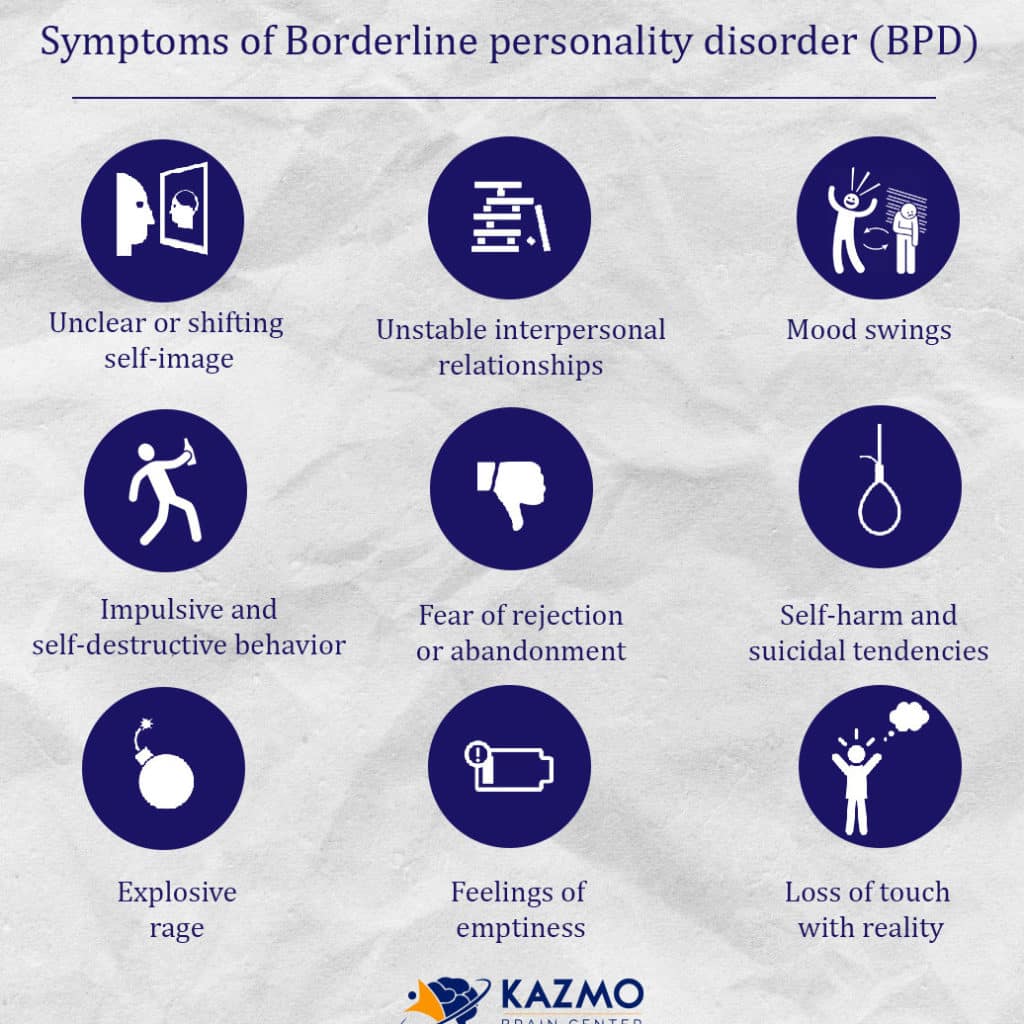Overview
Borderline personality disorder is an illness marked by an ongoing pattern of varying moods, self-image and behavior. These symptoms often result in impulsive actions and problems in relationships. People with borderline personality disorder may experience intense episodes of anger, depression and anxiety that can last from a few hours to days.
Signs and Symptoms Of Borderline Personality Disorder

People with borderline personality disorder may experience mood swings and display uncertainty about how they see themselves and their role in the world. As a result, their interests and values can change quickly.
People with borderline personality disorder also tend to view things in extremes, such as all good or all bad. Their opinions of other people can also change quickly. An individual who is seen as a friend one day may be considered an enemy or traitor the next. These shifting feelings can lead to intense and unstable relationships.
Other Signs or Symptoms May Include:
- Efforts to avoid real or imagined abandonment, such as rapidly initiating intimate (physical or emotional) relationships or cutting off communication with someone in anticipation of being abandoned.
- A pattern of intense and unstable relationships with family, friends and loved ones, often swinging from extreme closeness and love (idealization) to extreme dislike or anger (devaluation).
- Distorted and unstable self-image or sense of self.
- Impulsive and often dangerous behaviors, such as spending sprees, unsafe sex, substance abuse, reckless driving and binge eating. Please note: If these behaviors occur primarily during a period of elevated mood or energy, they may be signs of a mood disorder—not borderline personality disorder.
- Self-harming behavior, such as cutting.
- Recurring thoughts of suicidal behaviors or threats.
- Intense and highly changeable moods, with each episode lasting from a few hours to a few days.
- Chronic feelings of emptiness.
- Inappropriate, intense anger or problems controlling anger.
- Difficulty trusting, which is sometimes accompanied by an irrational fear of other people’s intentions.
- Feelings of dissociation, such as feeling cut off from oneself, seeing oneself from outside one’s body or feelings of unreality.
Not everyone with borderline personality disorder experiences every symptom. Some individuals experience only a few symptoms, while others have many. Symptoms can be triggered by seemingly ordinary events. For example, people with borderline personality disorder may become angry and distressed over minor separations from people to whom they feel close, such as traveling on business trips. The severity and frequency of symptoms and how long they last will vary depending on the individual and their illness.
When to See a Doctor
If you’re aware that you have any of the signs or symptoms above, talk to your psychiatrist, counselor or a mental health provider.
Causes of Borderline Personality Disorder
The causes of BPD are not fully understood, but scientists agree that it is the result of a combination of factors, including:
- Genetics, while no specific gene or gene profile has been shown to directly cause BPD, research suggests that people who have a close family member with BPD may be at a higher risk of developing the disorder.
- Environmental factors, people who experience traumatic life events such as physical or sexual abuse during childhood or neglect and separation from parents are at increased risk of developing BPD.
- Brain function, the emotional regulation system may be different in people with BPD, suggesting that there is a neurological basis for some of the symptoms. Specifically, the portions of the brain that control emotions and decision-making/judgment may not communicate optimally with one another.
Tests and Diagnosis of Borderline Personality Disorder
A licensed mental health professional—such as a psychiatrist, psychologist, or clinical social worker—experienced in diagnosing and treating mental disorders can diagnose borderline personality disorder by:
- Completing a thorough interview, including a discussion about symptoms.
- Performing a careful and thorough medical exam, which can help rule out other possible causes of symptoms.
- Asking about family medical histories, including any history of mental illness.
Borderline personality disorder often occurs with other mental illnesses. Co-occurring disorders can make it harder to diagnose and treat borderline personality disorder, especially if symptoms of other illnesses overlap with the symptoms of borderline personality disorder. For example, a person with a borderline personality disorder may be more likely to also experience symptoms of depression, bipolar disorder, anxiety disorders, substance use disorders or eating disorders.
Complications of BPD
Borderline personality disorder can damage many areas of your life. It can negatively affect intimate relationships, jobs, school, social activities and self-image, resulting in:
- Repeated job changes or losses
- Not completing an education
- Multiple legal issues, such as jail time
- Conflict-filled relationships, marital stress or divorce
- Self-injury, such as cutting or burning and frequent hospitalizations
- Involvement in abusive relationships
- Unplanned pregnancies, sexually transmitted infections, motor vehicle accidents and physical fights due to impulsive and risky behavior
- Attempted or completed suicide
Besides, you may have other mental health disorders, such as:
- Depression
- Alcohol or other substance misuse
- Anxiety disorders
- Eating disorders
- Bipolar disorder
- Post-traumatic stress disorder (PTSD)
- Attention-deficit/hyperactivity disorder (ADHD)
- Other personality disorders
Seek and Stick with Treatment
Borderline personality disorder has historically been viewed as difficult to treat. But, with newer, evidence-based treatment, many people with the disorder experience fewer or less severe symptoms and improved quality of life. People with borderline personality disorder must receive evidence-based, specialized treatment from an appropriately trained provider. Other types of treatment or treatment provided by a doctor or therapist who is not appropriately trained, may not benefit the person.
Many factors affect the length of time it takes for symptoms to improve once treatment begins, so it is important for people with borderline personality disorder and their loved ones to be patient and to receive appropriate support during treatment.
Studies show that people with borderline personality disorder who don’t receive adequate treatment are:
More likely to develop other chronic medical or mental illnesses, and less likely to make healthy lifestyle choices.
Borderline personality disorder is also associated with a significantly higher rate of self-harm and suicidal behavior than the general public.
People with borderline personality disorder who are thinking of harming themselves or attempting suicide need help right away.
The treatments described on this page are just some of the options that may be available to a person with borderline personality disorder.
Psychotherapy
Psychotherapy is the first-line treatment for people with borderline personality disorder. A therapist can provide one-on-one treatment between the therapist and patient or treatment in a group setting. Therapist-led group sessions may help teach people with borderline personality disorder how to interact with others and how to effectively express themselves.
It is important that people in therapy get along with and trust their therapist. The very nature of borderline personality disorder can make it difficult for people with the disorder to maintain a comfortable and trusting bond with their therapist.
Two examples of psychotherapies used to treat borderline personality disorder include:
Dialectical Behavior Therapy (DBT)
This type of therapy was developed for individuals with borderline personality disorder. DBT uses concepts of mindfulness and acceptance or being aware of and attentive to the current situation and emotional state. DBT also teaches skills that can help:
- Control intense emotions
- Reduce self-destructive behavior
- Improve relationships
Cognitive Behavioral Therapy (CBT)
This type of therapy can help people with borderline personality disorder identify and change core beliefs and behaviors that underlie inaccurate perceptions of themselves and others, and problems interacting with others. CBT may help reduce a range of mood and anxiety symptoms and reduce the number of suicidal or self-harming behaviors.
Medications
Because the benefits are unclear, medications are not typically used as the primary treatment for borderline personality disorder. However, in some cases, a psychiatrist may recommend medications to treat specific symptoms such as:
- Mood swings
- Depression
- Other co-occurring mental disorders
Treatment with medications may require care from more than one medical and mental professional. Certain medications can cause different side effects in different people. Talk to your doctor about what to expect from a particular medication.
To recover from Borderline Personality Disorder, you must believe that you deserve a happy normal life and you must not be shy about seeking mental help from a mental health therapist at Kazmo Brain Center.
Kazmo Brain Center is a counseling center in Frisco, Texas specializing in mental health and will work with you toward a happier and more satisfying life. If you or your loved ones are facing Borderline Personality Disorder and you think that you need help, Request an appointment at the Kazmo Brain Center and we are here to help.
Resource:
www.nimh.nih.gov






